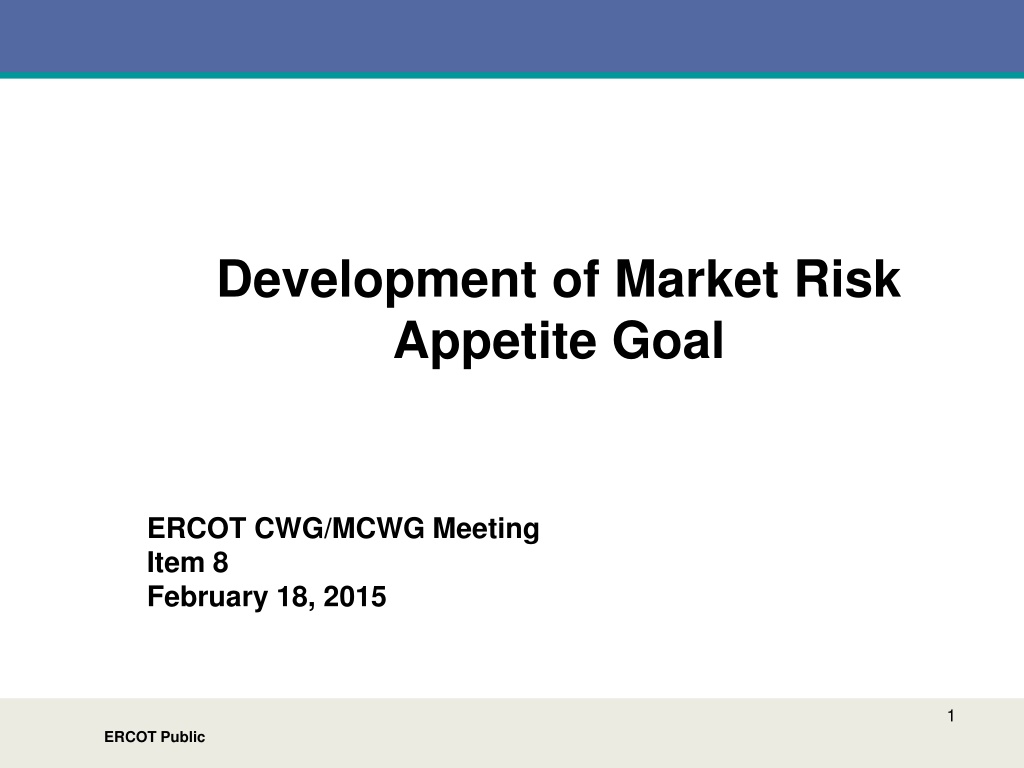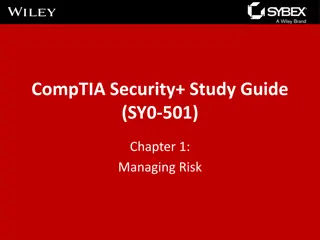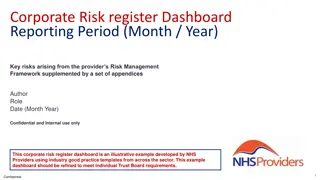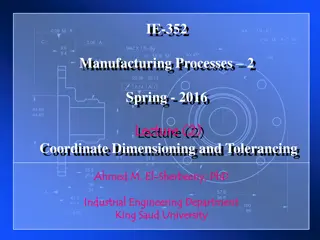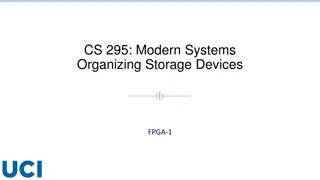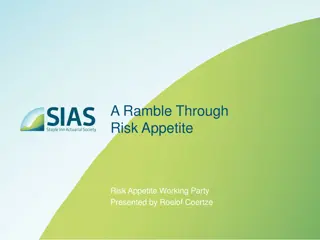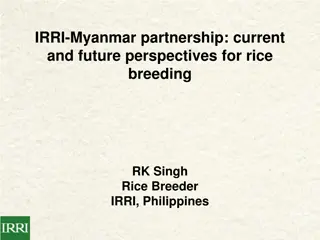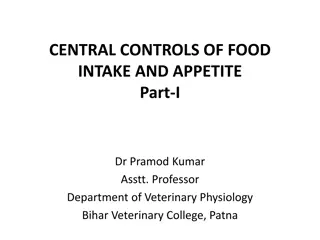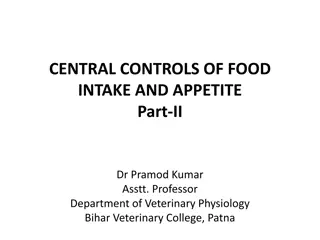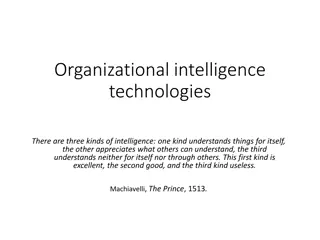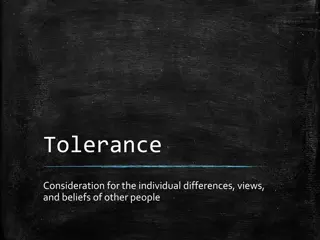Understanding Organizational Risk Appetite and Tolerance
Explore the development of market risk appetite goals and how to define and establish organizational risk tolerance. Learn about the Classic Simplified View of Risk Tolerance and different methods to determine risk appetite. Discover the importance of assessing market risk impact and aligning risk tolerance with strategic objectives.
Download Presentation

Please find below an Image/Link to download the presentation.
The content on the website is provided AS IS for your information and personal use only. It may not be sold, licensed, or shared on other websites without obtaining consent from the author. Download presentation by click this link. If you encounter any issues during the download, it is possible that the publisher has removed the file from their server.
E N D
Presentation Transcript
Development of Market Risk Appetite Goal ERCOT CWG/MCWG Meeting Item 8 February 18, 2015 1 ERCOT Public
Development of Market Risk Appetite Goal Background From the CWG Charter, two of the assigned functions are Providing input on credit matters as requested by the F&A Committee or by TAC or TAC subcommittees and Providing input regarding NPRRs that impact credit in accordance with this Charter and Board approved credit policies , further In carrying out its responsibilities, the CWG shall be guided by industry best practices Credit Work Group (CWG) has set itself a 2015 goal to clarify the market s risk tolerance / appetite level. A rationale for the goal is to enable a framework for reviewing the risk impact of NPRRs or other market changes relative to current market design. In its December 2014 meeting the F&A Committee requested additional guidance on how market risk might be assessed. 2 ERCOT Public
Classic Simplified View of Risk Tolerance (Convex Marginal Propensity to Risk Aversion) 3 ERCOT Public
How to Define Risk Tolerance or Risk Appetite Definition of Risk Appetite (Institute of Risk Management) Risk appetite can be defined as the amount and type of risk that an organization is willing to take in order to meet their strategic objectives . Organizations will have different risk appetites depending on their sector, culture and objectives. A range of appetites exist for different risks and these may change over time. 4 ERCOT Public
How to Establish an Organizational Risk Tolerance Several Methods Three Common are Described Qualitative (or gut feel ) Consensus Driven often done by surveys of key stakeholders Do you feel the Organization s goals and objectives would be compromised if there were a loss of $xxx? $yyy? zzz? Quantitative Scenario Driven often the result of some sort of probability analysis (such as a Value-at-Risk or Probability-of-Default calculation) employing basic statistical tools such as a probability distribution or transition matrix and historical pricing, variance, and covariance data in a stochastic or Monte-Carlo simulation with an associated time-weighted probability outcome Our analysis shows that there is a 10% chance of a 10-day loss exceeding $xxx and a 1% chance of a 10-day loss exceeding $yyy. Is that acceptable? Capital Capacity Driven A hybrid of a Consensus and Qualitative approach Collectively, we the key stakeholders, feel we can only survive a 10% chance of a loss of $xxx and a 1% chance of $yyy do what ever you can to make sure our losses do not exceed these levels! 5 ERCOT Public
Considerations in Establishing Risk Tolerances Key Considerations Different stakeholders will have different risk tolerances and risk appetites based upon their Expected Utility of Money which is unique to each stakeholder based upon, among other factors, their risk aversion and opportunity cost and cost of capital. These risk tolerances will likely change amongst stakeholders in a non-uniform manner at each point in the likelihood of outcome and probability of occurrence matrix. Qualitative Analysis of the Probability of Loss (one measure of exposure of a third-party to the non-performance of another) involves two components - the Exposure at Default which is often not overly difficult to calculate (although recovery rates differ) and Probability of Default which can be very difficult to calculate because it includes both public information available to the third-party as well as private information which as such is often modeled using default probability matrices developed by organizations such as Moody s or Standard & Poor s on a generalized basis and often useful only for rated companies. 6 ERCOT Public
ERCOT Specific Risk Tolerances Considerations ERCOT Risk Tolerance Considerations (non-exhaustive) ERCOT has multiple stakeholders, each with different risk appetites ERCOT measures Total Potential Exposure (TPE) as a proxy for default exposure, but does not maintain counterparty-specific default probabilities ERCOT does not have transparency into the capital structure of individual counterparties in order to estimate recovery probabilities ERCOT s measure of TPE may overstate market risk due to numerous assumptions and somewhat arbitrary parameters as well as a deliberate design to estimate potential and not probable exposure. ERCOT only sees its TPE exposure; however counterparties have other financial positions which may mitigate exposure (third-party financial hedges, generation outage exposure) or exacerbate exposure (short positions with third-parties, unhedged exposure to commodities such as natural gas needed to operate a plant during a basis squeeze ) ERCOT lacks the robust analytical tools to calculate portfolio-wide Monte- Carlo or parametric Value-at-Risk or other full quantitative analysis. 7 ERCOT Public
Next Steps and Questions? Next Steps? What can CWG/MCWG do to provide F&A with additional guidance on how market risk might be assessed ? Should we differentiate this guidance by normal risk exposure (however that is defined) and tail risk exposure ? How should this guidance be structured and what approaches (if any) should be taken in its development? When should we target providing this guidance? Questions? 8 ERCOT Public
